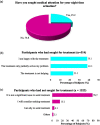Prevalence of nocturia among community-dwelling adults: a population-based study in Malaysia
- PMID: 34187440
- PMCID: PMC8243763
- DOI: 10.1186/s12894-021-00860-1
Prevalence of nocturia among community-dwelling adults: a population-based study in Malaysia
Abstract
Background: Nocturia is widely prevalent condition with detrimental effects on quality of life and general health. In Malaysia, there is a lack of up-to-date prevalence study on nocturia. This study aimed to investigate the prevalence of nocturia and awareness pertaining to nocturia among Malaysian adults.
Methods: A cross-sectional population-based study was conducted among Malaysian adults aged ≥ 18 years old. The data was collected by mixed mode self-administered questionnaire from May 2019 to September 2019. Nocturia was defined as one or more voids at night.
Results: There were a total of 4616 respondents with 74.5% of response rate. The overall prevalence of nocturia among Malaysian adults was found to be 57.3%. In multivariate analysis, respondents aged 31-40 (1.91 [1.52-2.40]) or > 60 years old (2.03 [1.48-2.71]), and those who presented with hypertension (2.84 [2.28-3.53]), diabetes mellitus (1.78 [1.42-2.25]), renal disease (3.58 [1.93-6.63]) or overactive bladder (1.61 [1.10-2.35]) were associated with higher prevalence of nocturia. A significantly lower disease prevalence (p < 0.05) was noted among those aged 41-50 (0.73 [0.59-0.91]), male (0.78 [0.69-0.88]) and Chinese (0.47 [0.30-0.74]) or Indian (0.34 [0.21-0.54]) ethnicities. A total of 37.3% of respondents with nocturia reported that they faced sleeping difficulty about half the time or more after waking up in the middle of night. Those who had ≥ 2 voids per night experienced significantly higher mean bother score than those who had 1 void per night (p < 0.001). Approximately half (56.7%) of all respondents were not aware that night time urination is a medical condition. Only 25.2% of respondents with nocturia had sought medical attention for their nocturia.
Conclusions: The prevalence of nocturia among Malaysian adults is high and strongly influenced by age, sex, race and comorbidities. However, the general awareness pertaining to nocturia being a health issue remains low among Malaysians. The findings also highlighted the impact of nocturia on sleep and the need for nocturia education to better address this disease.
Keywords: Awareness; Malaysia; Nocturia; Prevalence; Survey.
Conflict of interest statement
All authors declare that they have no competing interests. Ferring Pharmaceutical Malaysia provided financial support in respect of publication costs but had no influence on the content of the work.
Figures





References
-
- International Continence Society. Terminology discussion: Nocturia. 2018. https://www.ics.org/committees/standardisation/terminologydiscussions/no.... Accessed 17 Mac 2020.
MeSH terms
LinkOut - more resources
Full Text Sources

